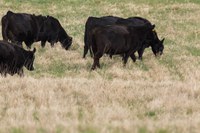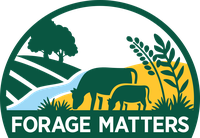Forage Matters: Plants and bears
(Click an image below to view a high-resolution image that can be downloaded)
By James Rogers, Forage crops production specialist
NDSU Extension
My mind was wandering the other day as I was enjoying one of our beautiful North Dakota summer days, and I started thinking about how we are in August. How many more of these nice warm days do we have before we start making preparations for winter? I found myself thinking about bears and how they prepare for winter by consuming all the food they can during summer and fall to build up the fat (energy) reserves that keep them alive during hibernation.
As my mind continued to wander, it struck me that perennial forage plants and bears have a lot in common with getting ready for winter.
Both need an opportunity to build and store food reserves prior to winter. Both survive winter by invoking a mechanism for avoiding the harshness of winter — hibernation for the bear and dormancy for the plant. Both have seasonal cycles. How both survive winter and thrive in the spring is based on how successful they were in storing food reserves the previous fall.
As days get shorter and we approach the end of the growing season, what are some considerations for preparing perennial forage plants for winter survival and spring growth?
Seasonal cycles
Photosynthesis is the plant process of converting solar energy into sugars used by the plant. Some of the sugars are used immediately, and if there is an excess of sugars, they are stored as carbohydrates in plant storage organs for regrowth and other functions. For alfalfa, carbohydrate reserves are stored in roots, and in grasses, storage is primarily in the leaf sheaths and stem base.
In spring, forage plants use stored carbohydrates to initiate growth until leaves are developed to the point that energy from photosynthesis is fueling plant growth. Any excess fuel is stored. If the plant is left undisturbed, it will continue to increase stored carbohydrates till it reaches maturity.
Forage plants are seldom left undisturbed; they are either grazed or cut and harvested as stored forage. When grazed or cut, the plant uses stored carbohydrates to initiate regrowth till leaf growth again reaches the point that photosynthesis generates an excess of sugars that are stored as carbohydrates. Through the growing season, there is a cycle of carbohydrate storage-use, storage-use. This continues to frost and plant dormancy.
The amount of reserves used for regrowth depends on the amount of leaf area remaining after grazing or cutting and the frequency of this occurrence. If the last use of stored carbohydrates for regrowth occurs so late in the season that reserves are not replenished, then we have potentially hurt capacity for spring growth and plant persistence. This is a manageable situation, and here are some thoughts on how to manage carbohydrate storage for long-term perennial plant health and persistence.
Alfalfa
A common question that comes up this time of year is this: How late can I harvest alfalfa and not hurt my stand from winter kill? Alfalfa needs 500 growing degree days or five to six weeks prior to a killing frost for carbohydrate reserves to build up, which for many areas will be early to mid-September. If this is an old alfalfa stand that will be coming out of production, then harvesting late does not really matter if the stand is going to be terminated in the spring. If forage is needed, delay harvest to a point where little regrowth will occur due to cold temperatures. This will be around mid-October when temperatures are consistently averaging 41 degrees Fahrenheit.
Another option would be to delay harvest until after frost. Alfalfa can also be grazed late in the season to extend the grazing season, but be cautious, as there is an increased risk of bloat with freeze-damaged alfalfa. Allow alfalfa time to dry down following a killing freeze prior to grazing to reduce bloat risk. If harvesting alfalfa late, leave 4-6 inches of stubble height for crown insulation and snow catch.
Perennial pasture
Research has shown that the intensity of grazing perennial grasses prior to winter dormancy does have an effect on their spring production. This effect is delayed spring growth and reduced forage biomass. This effect is much easier to manage if you are in some type of rotational grazing system.
If a paddock or pasture is intensely grazed late in the season prior to frost, then delay grazing this same paddock in the spring until it has adequate time to recover. This might mean delaying grazing that paddock until the plants are approaching maturity. This effect is much more difficult to account for in continuous grazing systems, as cattle are selective grazers and tend to select the same plants repeatedly if allowed.
Much like a bear storing food, our forage systems need winter preparation as well.
(James Rogers is a North Dakota State University Extension forage crops production specialist at the North Central Research Extension Center near Minot, North Dakota.)
NDSU Agriculture Communication – Aug. 14, 2025
Source: James Rogers, 701-857-7682, james.rogers.1@ndsu.edu
Editor: Dominic Erickson, 701-231-5546, dominic.erickson@ndsu.edu




